
A sign at Izmir airport
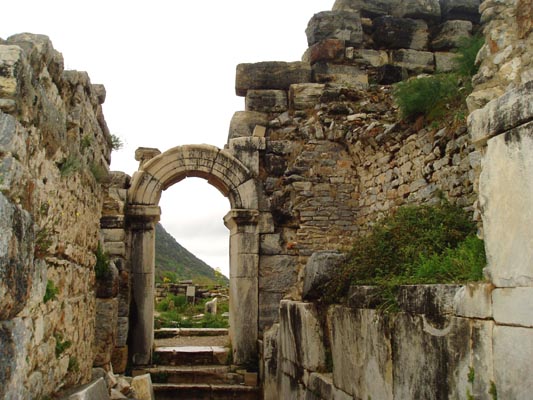
Arch at Ephesus
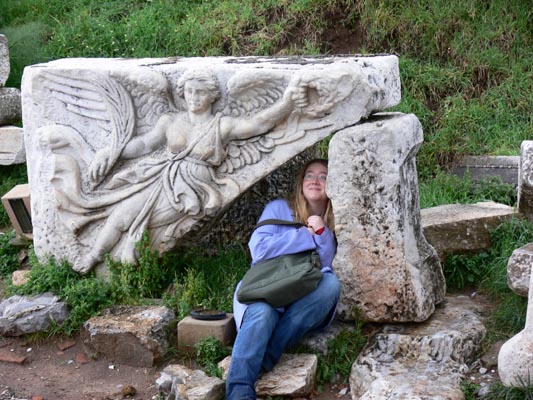
An angel flies over Maddi
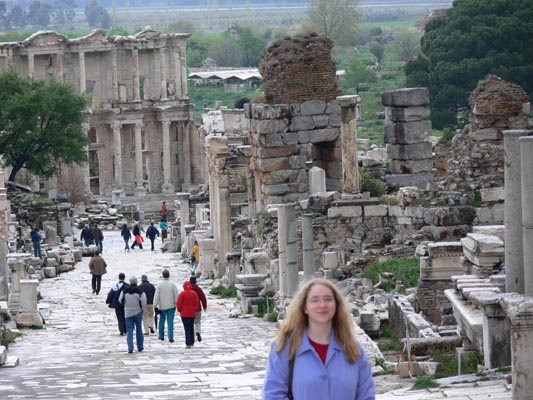
Looking down to the library at Ephesus
Our main vacation this year we took over the Easter break - we headed out to JFK late afternoon on Thursady March 30 and got on a Turkish Airlines jet bound for Istanbul. This was our delayed vacation from last summer, when Louise got sick just before we were to leave for Turkey. Going in the spring would allow us to avoid the crowds as well as the hottest of the summer weather, but might also expose us to the chilly, wet spring weather. As it turned out, the weather was not great, but it did little to chill our enthusiasm.
Our plan was to continue on from Istanbul to Izmir, on the Aegean, which is near the ancient city of Ephesus. Ephesus was a major city of a quarter of a million inhabitants, run at times by the Athenians, the Persians, Alexander the Great, the Romans and just about any other conquering army in those parts. It plays a role in early Christianity/Islam; it is believed that St. John and the Virgin Mary lived there. Also St. Paul lived there for a while, although he came down hard against graven images and the local silversmiths, fearful of losing business, had him kicked out of the city. Some of the artifacts have been moved away to a nearby museum in Sellçuk, but most of them are there for you to walk among, to touch and to imagine as a vibrant, living city.
After doing Ephesus, we planned to fly to Cappadocia, which is further East, in central Turkey. Its main claim to fame is that it was covered at one time by volcanic ash, which became a soft rock and was later covered by harder igneous rock. This resulted in extraordinary patterns of erosion and also was ideal for digging caves in, supporting vast numbers of troglodytic people.
Finally, back to Istanbul to spend our last 4 days trying to pack in all the sights of a great city of 18 million people.
Kuşadasi
After flying to Izmir, we took a taxi to Kuşadasi. We stayed in the Kismet hotel, overlooking the Aegean. The hotel was very fine and had a wall of fame with pictures of all the famous people who had stayed there. (This included HM the Queen, so I was pretty impressed.) I imagine the town and hotel are hopping in the summer when you can lounge on the beach if you don't want to see the ruins, but things were pretty quiet now. The weather was cool and intermittently rainy the first day we were there and we wondered if we should wait to do Ephesus before leaving on the following day. But we figured that at least we could see the museum, so the hotel arranged a taxi and driver for us for the whole day. After a quick 10 mile drive, we arrived in Selçuk - it was still raining, so we headed for the Blessed Virgin Mary House, built on the site of the house Mary supposedly spent the last of her days in. Its finest feature was a nearby spring which dispensed holy water, which you could buy at the roadside souvenir stand. The rain was still bucketing down when we finished with the BVM house and so we headed back into Selçuk for lunch and a trip around the museum.
When we were finished, the rain had stopped, so we decided to take a chance on visiting the site. The driver dropped us off at one gate and went around to pick us up at another one. The ruins were awesome, we all agreed. I was expecting a much more antiseptic experience, gazing at pieces of carved marble from behind a rope barrier, with a Turkish gendarme standing there with a submachine gun to keep you from getting too close. But instead, you could get up-close and personal, climb around on them as much as you wanted. Many of them were not totally excavated, so you could see exactly where they had stood all these centuries, so you could easily imagine what the city had been like then. Some of the buildings were in amazingly good shape - the library has a two story facade, complete with pillars and statues. At the end of the walk was the amphitheater, which could hold 20,000 people and which until quite recently had been used for concerts.
The weather was clearing as we returned to Kuşadasi and we were well satisfied with out day, wet socks or no wet socks.
The next day was gorgeous, so we walked around town sightseeing until we had to leave for the Izmir airport. We saw the local caravanserai, where the long-distance trading caravans would stop overnight. The stables had been turned into (what else?) carpet stores. We were greeted by a merchant "Hey, tourist - want to buy carpet?" How silly, we agreed; as if anyone would consider buying a carpet while on vacation! I mean, what are you going to do - take it back in your suitcase? (These words would come back to haunt us later in the trip.) We piled into the cab, were whisked away to the airport and then after a short 40 minute flight were in Kayseri, in Cappadocia.
 A sign at Izmir airport |
 Arch at Ephesus |
 An angel flies over Maddi |
 Looking down to the library at Ephesus |
Goreme
After landing in Kayseri, we had a long ride in a minibus before we entered Goreme and were dropped off at the Cappadocia Cave Suites. The hotel rooms are indeed carved into the rock and have an irregular, organic feel to them. But they also have every modern convenience - spectacular bathroom, maid service, minibar, wireless internet (although that last was a little flaky). After settling in, I chatted with the guy on reception about hiring a guide. He strongly recommended doing so, and in fact would be happy to do it for us. He mapped out two days of visiting all of the sights and told me it would run a mere $1,000. That sobered me up, and I started thinking about alternatives. The guy called the guide service and was astonished to find out that the price was actually only $800! Louise and I talked it over and we decided to do just one day for $400.
The next morning we got up to find a sprinkle of snow on the ground and grey threatening skies. At 10, our guide showed up, accompanied by a Mercedes minivan and a driver. His name was Murat; he was young, spoke good English and had an friendly, easy manner. The driver Ahmed had a more weathered appearance and spoke no English (or so he said).
Our first stop was the Goreme open-air museum. (I think the point of calling it that is so that they can charge an entrance fee.) This is a large area of caves that were used by Christians for religious purposes from over 1,000 years ago. It included both a monastery and a nunnery, with all the facilities required for living - kitchen, food store, dining room, etc. The monks would also store food in the caves for the rest of the village, since the cooler temperatures kept it fresh longer. There are also many small Christian churches with built-in altars. Many of these have elaborate religious paintings on their walls - either through applying vegetable dyes directly to the wall, or through first applying a kind of wash on the wall that provides a smooth painting surface. The second kind are call frescos - I thought they looked suspiciously colorful and fresh until I thought, hey, fresco is Italian for fresh, so it must be OK. There is also a nearby valley called pigeon valley, where the locals had at one time carved homes for pigeons into the rock walls so that they could harvest the droppings for fertilizer.
We then visited a workshop where they make objects (bowls, vases, jewelry) out of onxy. They started us out with a demonstration, in which an artisan takes a piece of onyx, secures it to a lathe and carves it into an egg, which he then gave to Toni. After the demo, we visited their shop, where they hoped we would buy more stuff, which we did.
The landscape around Goreme looks like something out of a Disney fantasy. It is full of "fairy chimneys", where the volcanic tuff (soft rock) has been eroded into a column, on the top of which is a cap of hard rock. There are rock houses everywhere where people have lived. There are also plenty of has-been rock houses, where pieces of the soft tuff have fallen away, giving a panoramic view from your exposed living room. It doesn't look like anything else I have seen on this planet.
The guide nicely managed to balance the need to show us cool stuff with the need to sell us things. We made one other lengthy stop in Avenos at a large pottery works. The scenario generally followed the one at the onyx works. First, an engaging young man talks to us and shows us a demonstration of how they make a plate. Then the girls are invited to try their luck on a kick wheel, and the bowls they produce are pronounced incredible - surely the work of a master! We drink tea. Then we see the show-room, which is huge, all in rooms carved into the rock. The pottery is wonderful - and in fact we keep seeing it later in Istanbul - but who in their right mind would buy pottery on vacation? We buy pottery.
By the end of the day, we were well satisfied with the sights we had seen as well as the stuff we had bought.
During the evening, I tried to get some work done for a client in Chicago, but everything went wrong. The internet connection was too flaky to let me download large files. I didn't have everything I needed on the laptop. Our transformer died and the laptop battery gave out. Let that be a lesson to all of you who think that you can just casually fit in some work when you are traveling abroad!. Although I was unable to finish the job that evening, the following day I was able to borrow a battery charger from the hotel management and get it done. This made it impossible for me to accompany the rest of the family on a trip to one of the underground cities - one of the must-see tourist destinations - but I was actually glad not to go, since I have a serious aversion to being buried alive. There are two of these cities near Goreme - the one Louise and the girls visited could shelter 20,000 people and everything they needed to live for a while - livestock, water, ventilation - while fending off marauding Arabs.
The following day (Wednesday), we got up early to take a minibus back to Kayseri so we can fly to Istanbul. Finally, the weather had changed and the sky was a beautiful blue. To our amazement, the sky was also filled with brightly-colored hot air balloons, which is said to be one of the very best ways of seeing the extraordinary landscape here.
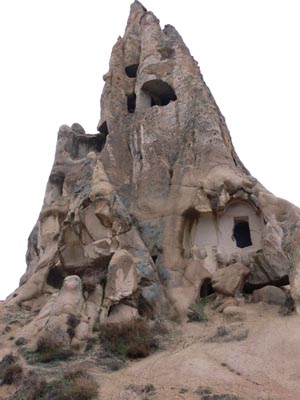 Cave houses in Goreme |
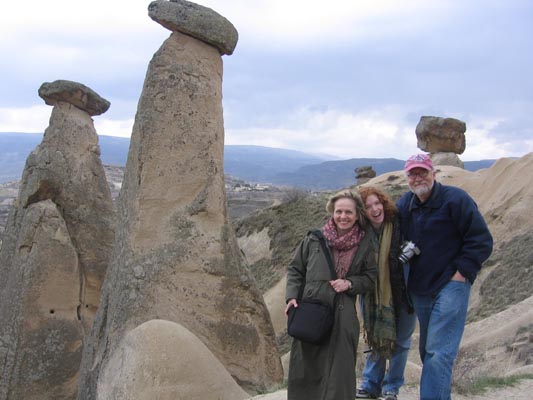 The L-D family by the rock family |
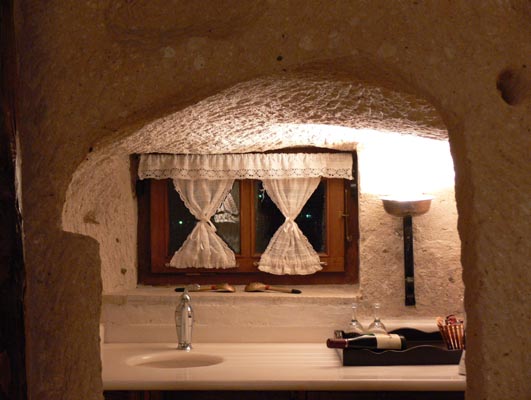 Our room in the rock |
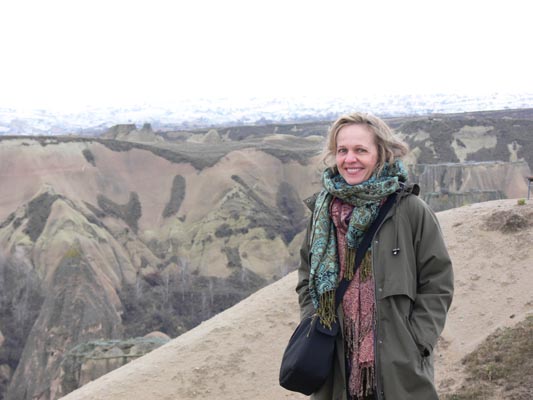 Louise overlooking Goreme valley |
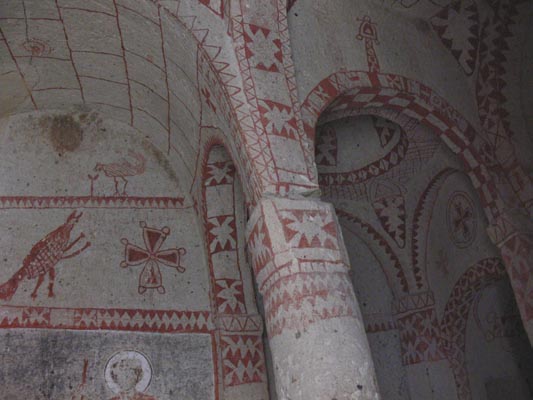 Paintings at Christian cave church |
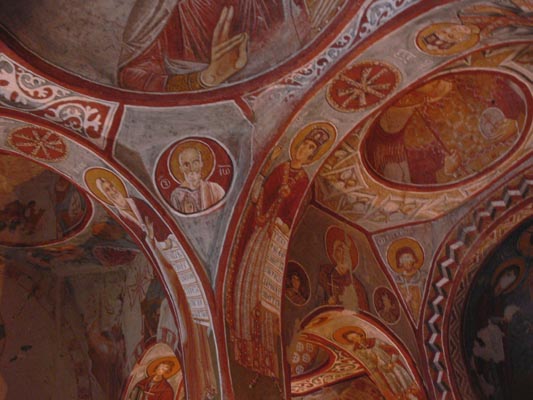 Frescos at Christian cave church |
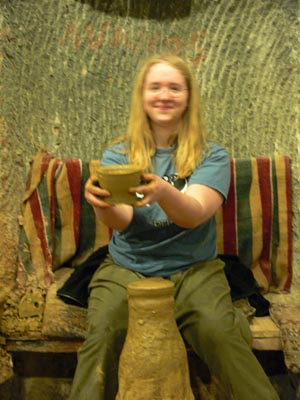
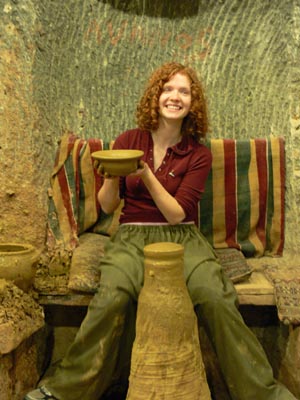
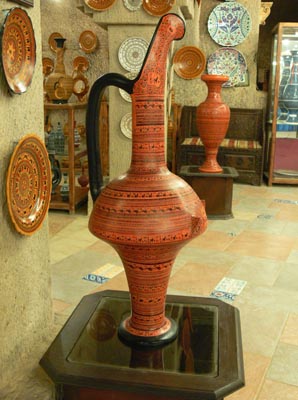 Madeleine and Toni show their prowess in throwing bowls; Hitite designs from red clay at the show-room |
|
 Louise at door of cave house |
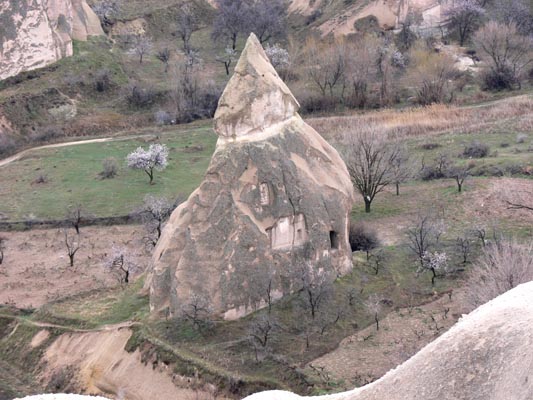 Hansel and Gretel's house? |
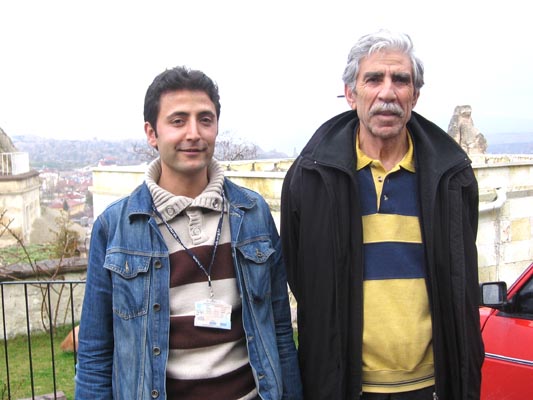 Murat and Ahmed |
|
Istanbul
This week included both easter and Mohamet's birthday, so we were unable to get four consecutive nights at one hotel. The first two days, we obtained rooms at the Daphne, in the Sultanhamet district, which is where a lot of the tourist destinations are. Then we had to pack up and go to Taxim, which is more like a 15 minute taxi ride away. Inconvenient, but not terminally so.
The taxi drivers in Istanbul seem to be even crazier than those in Manhattan. In every taxi we took, the driver seemed to never get more than 6 inches from any other vehicle in any direction. I found I felt better when I watched something else, like birds in the sky, rather than try to anticipate the next pile-up. The streets compound the problem - Sultanhamet streets are mostly cobbled, steep, narrow and two-way. I was profoundly glad we were staying close enough to the big attractions that we could walk to them.
On Thursday, we decided to take in the Topkapi palace. Outside the gate, we saw multitudes of school children filing in and we started to worry that it might be too crowded. Just then, a young man approached us and said in excellent English: I see that you are considering going to the Topkapi palace. But you might want to consider going to the Blue Mosque instead, which is only a five minute walk away. It is now 11; at noon, the mosque will be closed for the rest of the day so the carpet can be cleaned. Tomorrow is Friday, our Sabbath, and entrance for tourists will be very limited. The Topkapi palace, however, will be available to you the entire time. We thanked him for his advice, which sounded very sensible. Then we started to wonder what his angle might be, so we asked him if he was a carpet salesman. He laughed and said that he sold killim, not carpets. But then it turned out that killim was actually a kind of carpet and, yes, he would very much like us to come to his store in the nearby bazaar. His name was Ali and he came from Mount Ararat, in Cappadocia. We felt we should have despised him for his sneaky approach to us, but the advice seemed sound and he was not overtly aggressive. In the end, we felt he was just an appealing guy who happened to be a really good salesman. He offered to take us round the Blue Mosque and we agreed, so long as he didn't expect us to buy a carpet in return. Absolutely not, he replied. We went around the Blue Mosque, which was stunning, and Ali provided occasional helpful information. The mosque was both complex and simple at the same time. It had almost no furniture, no altar, pews, lecterns and the like, just a huge carpet for the faithful to kneel on. There were stained-glass windows and pillars, but the overall effect was light and relaxing, not imposing or intimidating. On the other hand, there are supposedly millions of hand-painted tiles on the dome and on the walls. Very beautiful. It is even more stunning on the outside - there is something perfect about the combination of the dome and the minarets. Anyway, I'm a big fan, as you can tell.
After the mosque, we agreed to visit Ali's shop. He kept insisting that we had absolutely no obligation to buy anything, and every time he said that, we said to ourselves: what a splendid fellow he is to insist so - to reward his gentlemanly conduct, I must buy a carpet from him. And, sure enough, when we got to his shop, we drank his tea, he started rolling out the wares, we reached for our wallets. After some perfunctory bargaining, we had agreed to buy a sumak from him, which is actually more like an embroidery than a carpet. There is a cotton weave and then the pictures are embroidered on it in silk thread. Because of his coming from Mount Ararat, many of the rugs, including the one we bought, feature animals from Noah's ark in the design. The good news is that it folded up quite small and we were indeed able to stuff it into our suitcase. They are intended to be used as rugs on the floor, but we are still considering using ours as more of a show piece, decorating a chest.
Next, the Aya Sophia, a church later converted into a mosque. It has a much darker, more oppressive feel. The very top of the dome is being restored, and there is regular scaffolding going all the way to the top, which looked amazing. I always wondered how they got to work on the ceiling in these huge spaces.
On Friday, we checked out the Topkapi palace again, but it again looked very crowded. So we headed for the Spice Bazaar instead, where we bought Turkish delight. Next, the Grand Bazaar, bigger than the Spice Bazaar, but more touristy. It was huge, although many of the little stalls seemed to be selling the same stuff - fabric, carpets, trinkets, jewelry. At some point, all the men took off their shoes and began praying, which seemed very alien in a boisterous crowded market.
When we got back to the hotel, we had to pack up to head to our next hotel. We piled into a taxi, but I couldn't find the voucher for the hotel, so I confidently pronounced that we were going to the Pallas Gervais. The driver, who spoke no English, didn't recognize the name of the hotel, and was obviously really pissed at these ignorant tourists. Eventually, a colleague of his proposed a destination and off he went to the Germir Pallas which providentially turned out to be the right hotel.
On Saturday, we took a ferry on the Bosporous almost all the way up to the Black Sea. It was relaxing but the girls pronounced it boring and said they were ready to go home to Larchmont. We stayed a couple of hours at the final stop and had lunch before returning.
Saturday night was unexpectedly exciting. We were looking for a restaurant to have our last supper in Turkey and found ourselves near Taxim square surrounded by thousands of young people striding about purposefully, although we were far from sure what they were actually doing. We strode about with them for a while and then found a restaurant on a side street where we dined in great style.
On Sunday morning, we hopped into a taxi and headed for the airport. We were in plenty of time for the flight, giving us time to dispose of our remaining lire any way we could. The plane was full and the flight was long but eventually we found ourselves back at JFK, tired but also exhilarated by the memory of perhaps the best vacation ever.
 The Blue Mosque |
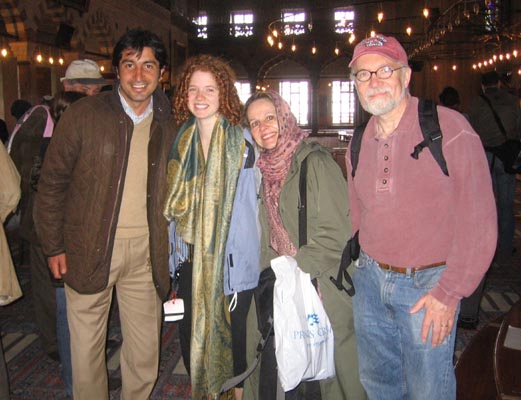 Inside the Blue Mosque with Ali |
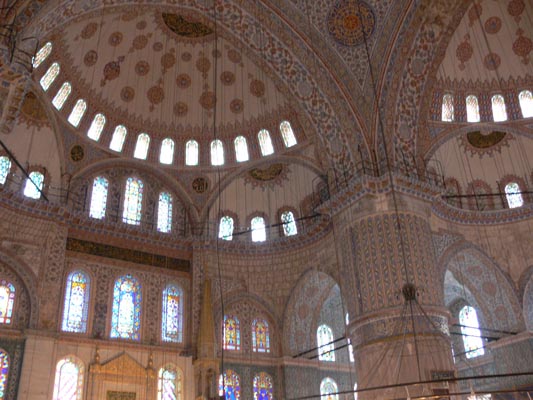 Interior of the Blue Mosque |
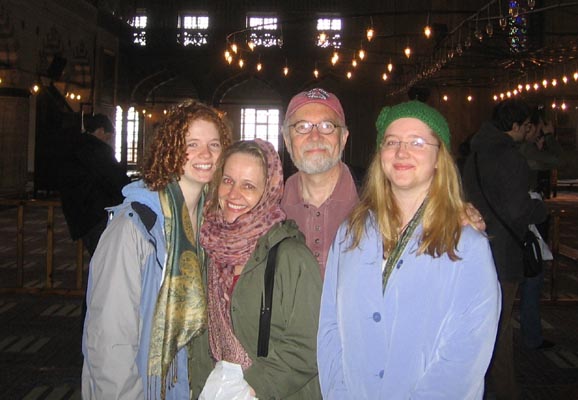 L-Ds in the Blue Mosque |
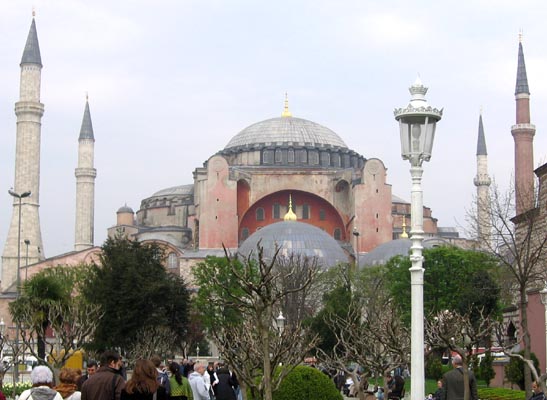 The Aya Sophia |
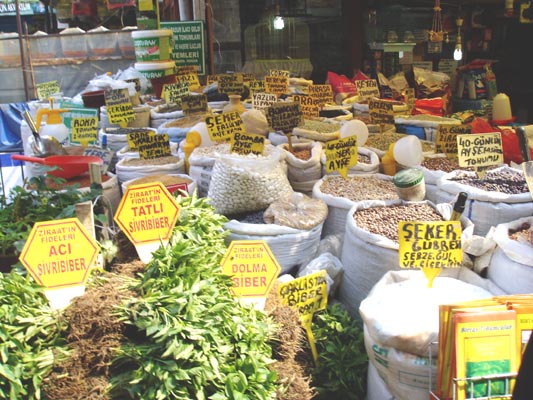 The spice bazaar |
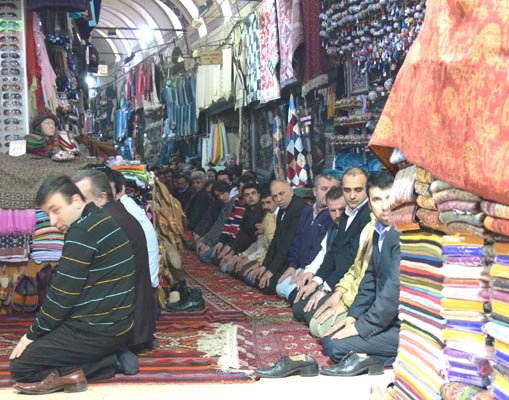 Prayer at the grand bazaar |
 The ubiquitous Turkish tea |
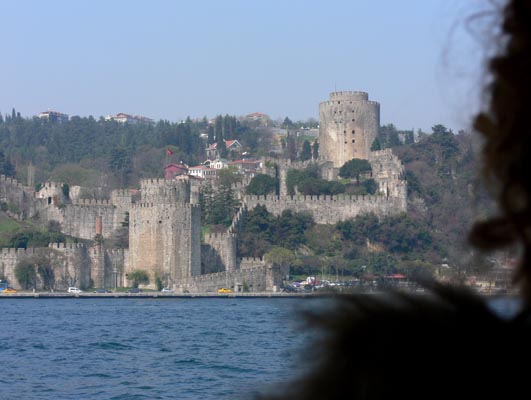 Castle on the Bosporous |
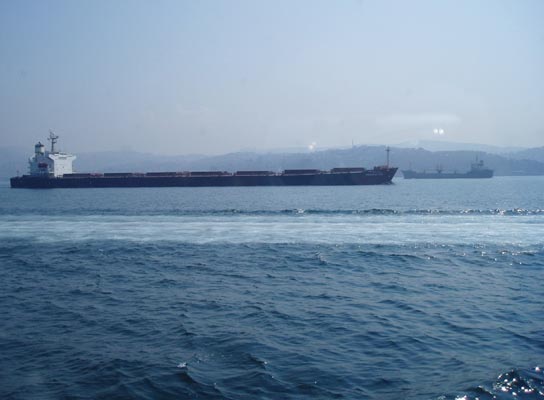 Freighter on the Bosporous |
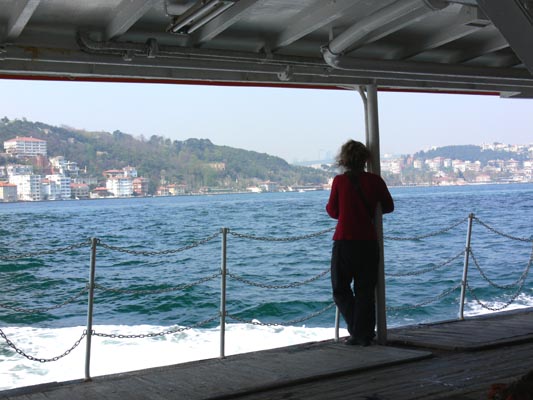 Louise and the Bosporous |
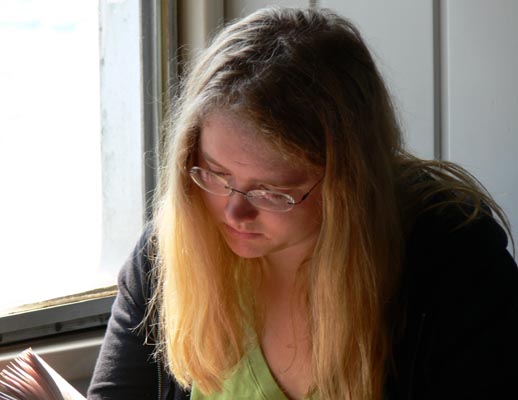 Maddi on the ferry |
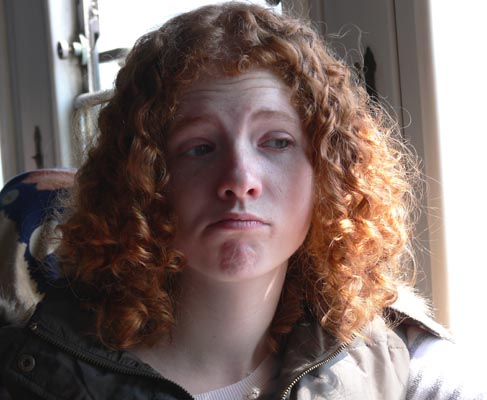 Toni on the ferry |
Copyright © 2007 by Peter Lloyd-Davies. All rights reserved. Privacy Statement.